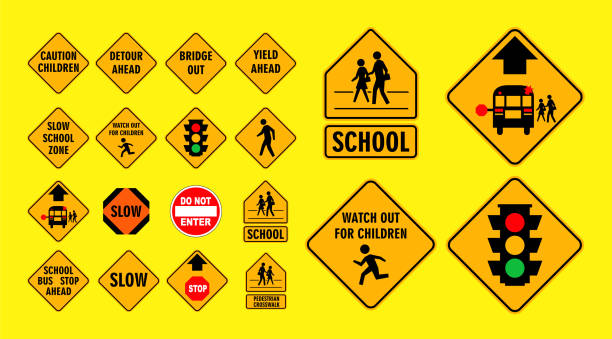Ensuring the safety of students during their commute to and from school is a top priority for educators, parents, and local governments alike. One of the most straightforward yet powerful ways to promote road safety near schools is by implementing effective traffic signage. In particular, the school zone sign plays a critical role in alerting drivers to reduce speed, stay vigilant, and protect young pedestrians. Unfortunately, the importance of clear and durable signage is often underestimated—until a tragedy reminds a community of what was lacking.
In this article, we’ll explore why every school needs high-quality school zone signs, their impact on road safety, and how schools can choose signage that will last.
The Purpose of School Zone Signs
School zone signs are a form of traffic control specifically designed to protect children around educational facilities. These signs are strategically placed around the perimeter of a school and serve several key purposes:
- Alerting Drivers: The primary function is to warn drivers that they are entering a zone with high pedestrian activity, specifically young children who may be less aware of road dangers.
- Reducing Speed: School zone signs are often accompanied by posted speed limits (typically 15–25 mph), flashing lights, or pavement markings that indicate the need to slow down.
- Improving Pedestrian Awareness: These signs make crossing zones more visible, helping students know where it is safe to walk or bike.
- Regulating Traffic: They help reduce traffic congestion and chaotic drop-offs by guiding drivers toward appropriate loading and parking zones.
Without these indicators, drivers may not realize they’re near a school, especially if they are unfamiliar with the area, potentially leading to dangerous situations.
The Risks of Inadequate Signage
When a school zone sign is faded, damaged, poorly placed, or missing altogether, it can significantly undermine student safety. Here are just a few of the risks:
1. Increased Speeding Incidents
Drivers are far more likely to maintain regular speed limits if they are not made aware that they are in a school zone. A lack of visual cues can cause vehicles to speed through areas where children may be crossing the street or walking alongside the road.
2. Confusion and Legal Liabilities
If signage is unclear, ambiguous, or non-compliant with municipal codes, it can cause confusion for drivers and pedestrians alike. Worse, it opens the door for legal liabilities. In the case of an accident, schools and districts may be held accountable for insufficient signage.
3. Lower Community Trust
Parents and guardians expect school administrations and city planners to prioritize safety. If a school zone lacks appropriate signage or if signs are visibly deteriorating, it may signal a lack of care or attention to the well-being of students.
The Importance of Durability
Not all signs are created equal. A school zone sign is exposed to the elements—sun, wind, rain, snow, and pollution—which can lead to fading, corrosion, or physical damage over time. That’s why durability is a key consideration when investing in school zone signage.
Benefits of Durable Signs
- Long-Term Cost Savings: Investing in high-quality materials like aluminum with reflective sheeting means fewer replacements and repairs over time.
- Visibility in All Conditions: Weather-resistant and reflective signs maintain visibility in fog, rain, and even at night, which is crucial during early morning drop-offs or late after-school programs.
- Compliance with DOT Standards: Durable signage that meets or exceeds local and federal Department of Transportation standards ensures that schools are not only safer but also legally protected.
Durable signs are not just about lasting longer; they’re about functionality and reliability when it matters most.
Key Features of an Effective School Zone Sign
When selecting a school zone sign, there are several important features to prioritize:
1. Reflectivity
Signs should include high-intensity or diamond-grade reflective sheeting to ensure maximum visibility during all hours of the day and night.
2. Standardized Symbols
School zone signs must be universally recognizable to be effective. Stick to MUTCD (Manual on Uniform Traffic Control Devices) guidelines, which dictate specific shapes, colors, and symbols.
3. Vandal-Resistant Coating
Anti-graffiti and scratch-resistant coatings ensure that the sign remains legible and aesthetically professional.
4. Mounting Flexibility
Signs should be easily mountable on posts, walls, or fences, depending on the school’s layout and road configuration.
5. Flashing LED Options
In high-traffic or accident-prone areas, solar-powered flashing signs can be highly effective in drawing attention and enforcing reduced speed limits.
The Role of Schools and Municipalities
While cities and transportation departments often manage traffic signage, schools should actively advocate for the appropriate placement and upkeep of school zone signs. This includes:
- Conducting Safety Audits: Regular reviews of traffic patterns and signage effectiveness.
- Reporting Damaged or Obscured Signs: Prompt notification to the city when signs are missing or need replacement.
- Partnering with PTAs and Community Groups: Parents can be powerful allies in raising awareness and securing funding.
- Applying for Grants: Programs like Safe Routes to School (SRTS) offer financial support for safety infrastructure, including signage.
By taking an active role, schools ensure that they are not passively waiting for issues to be addressed—they become proactive stewards of student safety.
Real-World Success Stories
Across the country, communities that have invested in modern, durable school zone sign systems have seen measurable improvements in student safety.
- Seattle, WA: After upgrading school zone signs to include solar-powered flashing beacons and high-reflectivity materials, some schools reported a 20% reduction in speeding violations.
- Austin, TX: The implementation of standardized school zone signage, coupled with parent-led patrols, improved pedestrian safety and community trust.
- Chicago, IL: Using a mix of LED signs and radar speed displays, schools significantly lowered traffic incidents in historically high-risk areas.
These case studies demonstrate that effective signage is not a luxury—it’s a necessity with a proven track record.
Make School Zone Safety a Priority
A school zone sign may seem like a simple addition to the landscape, but its impact can be lifesaving. Clear, durable signage ensures that drivers are fully aware of their responsibilities and that students can travel to school safely each day.
Given the increasing concerns about distracted driving and congested school drop-off zones, now is the time to assess and upgrade your school’s signage. Durable, highly visible, and code-compliant school zone signs are a wise investment—not only in infrastructure but in the safety and trust of the entire school community.
Every school deserves the peace of mind that comes from knowing students are protected the moment they set foot near campus. And it starts with something as fundamental as the right sign in the right place.






